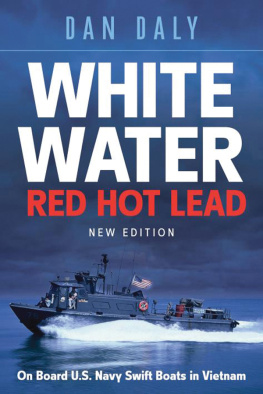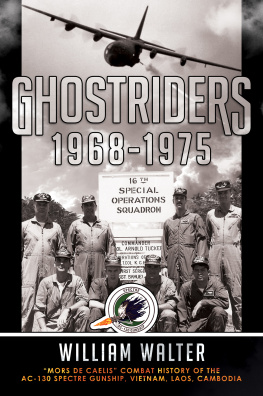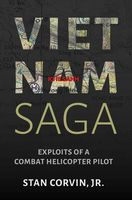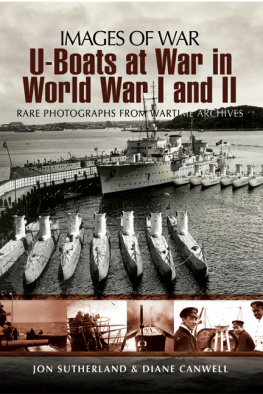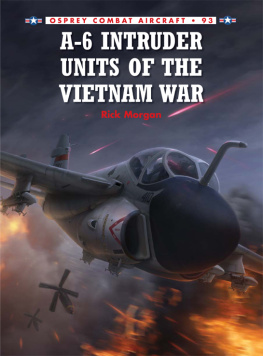
WHITE WATER RED HOT LEAD
On Board U.S. Navy Swift Boats in Vietnam
DAN DALY
Published in the United States of America and Great Britain in 2017 by
CASEMATE PUBLISHERS
1950 Lawrence Road, Havertown, PA 19083, USA
and
The Old Music Hall, 106108 Cowley Road, Oxford OX4 1JE, UK
Copyright 2017 Dan Daly
Hardcover Edition: ISBN 978-1-61200-478-5
Digital Edition: ISBN 978-1-61200-479-2
Mobi Edition: ISBN 978-1-61200-479-2
A CIP record for this book is available from the British Library.
All rights reserved. No part of this book may be reproduced or transmitted in any form or by any means, electronic or mechanical including photocopying, recording or by any information storage and retrieval system, without permission from the publisher in writing.
Photography by Dan Daly unless otherwise stated
Map illustrations by Maritime Museum of San Diego
For a complete list of Casemate titles, please contact:
CASEMATE PUBLISHERS (US)
Telephone (610) 853-9131
Fax (610) 853-9146
Email:
www.casematepublishers.com
CASEMATE PUBLISHERS (UK)
Telephone (01865) 241249
Fax (01865) 794449
Email:
www.casematepublishers.co.uk
This book is dedicated to all my Swift Boat shipmates with whom I had the honor to serve. To all veterans, a sincere Thank you for your service. To my fellow Vietnam veterans, Welcome home.
ACKNOWLEDGEMENTS
My appreciation to Mike Zak: friend, venture capitalist, military historian and former Marine, for his support, comments and realistic guidance. My thanks to David Gallagher for his ongoing effort in many areas, both mechanical and manuscript. In terms of content, Ed Bergin and his description of his crews capture of the enemy trawler was invaluable. Thanks also to Tom Jones and his crew for describing the rescue of four of my crew, which fine-tuned the story. Joe Patton, Bill Franke, Virg Irwin, Larry Irwin, Stirlin Harris and Michele Bernique provided not only the first-hand combat content, but photographs for the composite story of Swift operations out of An Thoi.
Neva Sullaway applied her personal writing and editorial experience, along with insight gained from her years publishing the Maritime Museum of San Diegos Pacific Maritime History Journal. She has made our product better and the experience more enjoyable and now she is a senior scholar of Swift Boat history.
My sincere thanks to them and other friends for their comments and encouragement.
PREFACE
This nonfiction story is not a broad-based history of the Vietnam conflict; it is the story of young men from across the United States who volunteered to serve their country in a type of duty that had not been seen since the PT Boats of World War II.
In Vietnam, those in Swift Boats experienced naval combat in the closest confines imaginable, where the enemy was hidden behind a passing sand dune or a single sniper could be concealed in an onshore bunker, mines might be submerged at every turn and fork in the river. The enemy was not over the horizon or miles away; he was all around you, right in front of you at the next turn, hiding, waiting, while your fifty-foot Swift Boat works its way upriver. In many cases, the rivers became so narrow there was barely room to maneuver or turn around. The only way out might be straight into a deadly ambush.
The average Swift Boat skipper was twenty-four years old and enlisted crewmembers averaged about the same. A routine day could start with sunshine and calm seas, switch instantly to deadly combat, be torn apart by a terrifying storm and end with a well-deserved beer back at the base.
These stories make you part of the Swift Boat crew. Youre at the helm doing 30 kts with your left hand locked on the throttles. Firing the.50 caliber machine gun is now your responsibility. Your eyes ache and your brain is dizzy from searching the shoreline with binoculars. Wind is up, youre 90 miles from base and the horizontal monsoon rain has just returned. It suddenly dawns on you that the enemy is hidden on shore just 100 yards away and he intends to kill you. At days end, you and your shipmates are flat ass tired but youre glad to be alive, if only to fight another day.
This book is composed of actual stories that I had the honor to be part of, or they were stories that were told to me by first-hand participants. I did not serve in the southern patrol areas, but the individuals mentioned and their crews did serve there and it is their stories that I have woven together.
Bob Mack is a composite character who provides continuity to a fifteen-month story. Navy nurse Kate Hancock is a fictional name, but her story contains a great deal of real memories for me and she is someone who has been dear to me for over fifty years and knows this story well.
Dan Daly
SWIFT BOAT TERMINOLOGY
Intending no insult, the bow is the pointed front end of the boat/ship; the stern is the flat backend of the boat/ship. The port side is the left side of the boat as you face forward and the starboard is the right side as you face forward. One does not go back aft or down below because one word is sufficient. One goes aft or one goes below.
Big Jimmie diesels were the main propulsion engines of the Swift Boat, each 480 hp. The term Jimmie refers to the manufacturer, General Motors Detroit Diesel. Swifts also had a small Onan diesel generator that put out 110 volts of electricity and carried 750 gallons of diesel fuel which would allow approximately 30 hours of long-range patrol, transit and on station.
Electronics on Swift Boats were very basic and included commercial non-military Decca (British) 202 radar with an accurate range of 1215 miles. The main radio was a single-sideband model with a range of 50 to 100 miles. We had numerous short-range FM radios with clearer transmissions that we used to communicate with onshore troops. Swifts also had a single depth sounder (fathometer). There were no other navigation devices on board other than the compass.
The gun tub was the small round circular structure on top of the pilothouse and was the location for the twin.50 caliber mount.
The radar mast was located just behind the pilothouse and the gun tub. It was a platform for the radar antenna along with various signal lights and the American flag.
The fantail or aft deck was the flat area that extended from the main cabin to the stern. In the middle of that area was located the 81mm mortar and a single.50 caliber machine gun. Closer to the main cabin were the large hatches that opened to the engine room. The large horizontal locker storing mortar ammunition was located at the stern.
A Swift Boat had two wheels or steering stations , one in the pilothouse and a stand-up wheel located port side at the rear of the main cabin. Throttles and gear shifts were available at both locations.
In the Navy, lines are used to tie up ships and boats. Ropes are for cowboys.
The Navy and the Air Force use charts, the Marines and the Army use maps.
Telling time: military time is calculated in terms of a 24-hour day. For example, 2 A.M . is 0200, 2 P.M . is 1400. PM time is simply the hour 2 added onto 1200, ergo 1400.
Weapons
The twin.50 caliber machine guns on a Swift Boat were located in the gun tub, which could be entered by crawling up from inside the pilothouse or by climbing into it from the main cabin roof top. Each gun fired approximately 500 rounds a minute. A fired.50 caliber round is about the size of your thumb and it is classified as a heavy machine gun. Stored below the deck in the main cabin we carried 15,000 to 20,000 rounds of belted (linked together).50 caliber ammunition. The other.50 caliber was a single gun located on a fixed pedestal in the middle of the after deck. Below that gun was the 81mm mortar which could be trigger or drop fired, one round at a time. It had a range of up to two miles and we carried anywhere from 80 to 100 rounds in a large ammunition locker located aft on the fantail.
Next page
